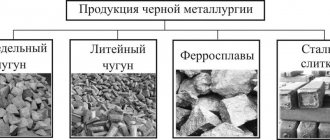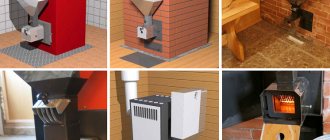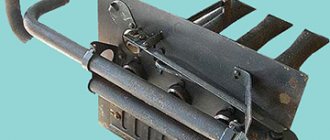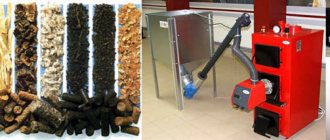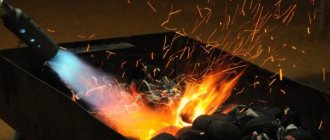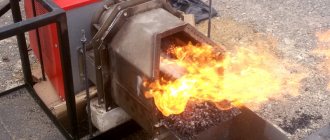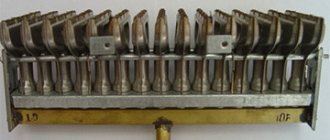Technical characteristics of the gas boiler AGV 80
The main indicator of heating equipment is power. However, another parameter is encrypted in the name of the model - the tank volume, which is 80 liters.
Important technical characteristics include:
- The heating time of water in the tank is 60-70 minutes.
- The temperature range of the liquid is 40-90°C.
- Efficiency is 80%, in modern versions it is higher – up to 85%.
- Thermal power – 7 kW (and heating capacity – 5.7 kW). The heated area is small: even with minimal heat loss, it is 60 m². Therefore, the boiler is suitable for small country houses or city apartments that cannot be connected to central heating.
Gas consumption is small, but given the low (compared to modern boilers) efficiency, this characteristic is unimportant.
Despite the spacious tank, the model does not take up much space. With a height of 1560 mm and a diameter of 410 mm, it is easy to find a suitable area for the device. The total weight of the equipment is 85 kg.
New generation of AGV
The AGV manufacturer was in no hurry to discontinue its popular boilers due to obvious advantages. However, technical progress also affected this equipment: during modernization, significant changes appeared in their design:
- Unreliable glass thermometers have been replaced with durable Italian ones.
- The new systems are equipped with automatic equipment from the American company Honeywell.
- To turn on the device, a piezo lighter is used with the handle.
- New coating technology has improved the appearance of the boiler.
Boiler AGV 80 technical characteristics are impressive
Design Features
The main elements of the boiler are:
- galvanized tank with a volume of 80 liters, the walls of which are not subject to corrosion;
- heat exchanger - a flame tube equipped with a heat flow extension and passing through the center of the tank;
- the main burner that ensures the operation of the coolant;
- devices for ensuring automatic safety (thermocouple, solenoid valve, igniter, draft sensor, thermostat);
- valve for supplying gas to the burner.
The boiler design includes thermal insulation of a galvanized tank. Mineral wool is used for these purposes.
The solenoid valve controls the flame. The part consists of gas and electromagnetic parts, between which a membrane is placed. The thermocouple is a soldered structure made of metal wires chromel and copel.
If the required temperature is maintained at the junction of dissimilar conductors that are connected in series, then a closed circuit with thermoelectric current is obtained. The work is based on the Seebeck effect: a thermocouple heated during gas combustion creates an electric current. The latter ensures the operation of the automatic protective component.
More complex modern modifications of boilers are also produced:
- AOGV - single-circuit models intended only for heating;
- AKGV are combined devices that allow you to additionally obtain hot water.
Despite the fact that many details have been improved, both models are practically no different in design from their predecessor.
AOGV uses a complex thermoregulation system to control temperature, which includes special sensors and valves. As soon as the indicator reaches a predetermined value, automatic devices are activated and the gas supply is stopped.
The system operates from an electric current created using a thermocouple. Expensive versions of AOGV use thermostats that give a warning signal for the owner to adjust the temperature. The AKGV boiler is equipped with the same sensors for convenience and safety.
Principle of operation
The main element of the AGV design is a galvanized cylindrical tank. It is connected to the heating system of the house through pipes. Inside the tank there is a flame tube - a heat exchanger that heats up when gas is burned.
In classic models, which include the AGV-80, a turbulator is placed in the tank, the operation of which increases the efficiency of the installation.
The heating system itself is a network that includes:
- rising pipeline for hot water;
- radiators;
- expansion tank;
- return pipeline.
This provides a full cycle of equipment operation, which can be represented as the following algorithm:
- Heating of the coolant due to gas combustion.
- Lifting liquid through an ascending pipeline to the radiators.
- Heat transfer.
- The reverse flow of water into the device, where the heating cycle is repeated again.
Such a system is called thermosyphon. It is based on natural circulation. Therefore, for full operation, additional components (for example, a circulation pump operating on electricity) will not be needed.
AGV is one of the energy-independent models of heating equipment. Compensation for water losses in such devices occurs from the expansion tank.
The design of the AGV allows you to install an external pump and provide forced circulation of liquid. But then the house needs to be able to connect it to a stable power supply, otherwise you will have to buy a UPS and a generator.
The system is based on the principles of natural traction. The air for the operation of the unit is taken from the room, and combustion products are discharged through a pre-installed chimney.
Advantages and disadvantages
Despite their apparent simplicity, AGV-80 boilers have such advantages as:
- Comparative ease of installation and ease of further management and maintenance. This concerns the safe regulation of water temperature within a predetermined range.
- The tank is made of metal, corrosion-resistant, strong and durable.
- Manufacturing of important components and parts using high-precision modern technologies. They are considered sensitive to the slightest changes in system operating parameters.
- Energy independence. The operation of AGV does not require stable network operation, costs for checking sockets and wiring, or adapting the system to increased load.
- Virtually silent operation. There is no circulation pump and fan.
Installing an AGV means that the pipework in the heating system can be made from any materials - cast iron, steel and heat-resistant metal-plastic.
The operation of the unit does not depend on gas pressure differences in the network. Well-thought-out protection allows you to turn off the system in time when the pressure drops.
Compared to models equipped with a circulation pump and fan, AGV has lower efficiency and does not have remote control.
There are technical features that lead to destruction of the device. For example, if the water temperature in the system drops below +50°C, abundant condensation begins. Unlike modern models, it is not used in any way in such boilers, but it is capable of extinguishing the flame.
When combustion products mix with condensate, sulfuric and nitric acids are formed. The latter are harmful to human health and equipment because they lead to corrosion.
When the temperature drops below 50°C, water circulation in the system stops. If we are talking about a private house in which no one lives in winter, the liquid must be drained and replaced with “anti-freeze”.
Advantages and disadvantages
AGV heating using boilers of this type can significantly increase the comfort of living. Like any technology, they have their own set of advantages and disadvantages.
- Energy independence. The boiler does not require a connection to electrical networks; it will work all the time as long as there is gas in the pipe.
- Simplicity. Pipe, burner, tank. Operation is possible by unqualified personnel, which reduces its cost.
- Optimal efficiency - at higher values, condensate will flow through the pipe, at lower values, heating costs will increase.
- Relatively small in size.
- Acceptable price.
- Outdated design.
- Condensation of moisture from the atmospheric air on the bottom mirror of the boiler and a leak, which can extinguish the burner. The effect is observed until the coolant reaches a temperature of 25-30 0 C.
- To completely interrupt the gas supply, the thermocouple must cool down. This takes up to a minute, which can be fatal in an accident.
- Ergonomics are not very good - pipelines and controls are open. It is difficult to coordinate the boiler with the interior design.
- To ignite the burner, you need to handle an open flame, which in itself is dangerous.
Installation Tips
The rules for installing equipment are simple:
- Before starting work, carefully read the instructions for the unit.
- When installing an AGV, organize a separate room for it, since this type of equipment takes air from the room.
- Provide good ventilation.
- Equip a chimney. It must be no less than the diameter of the pipe (minimum length - 5 m, horizontal section - up to 3 m).
- Clean the device through a special hatch. Since the chimney runs outside the house, debris and condensation collect in it, causing the structure to fail.
- When installing the boiler, leave a free space in front of it within a radius of 1 m, the distance to the nearest wall is at least 2 m.
The walls and floor in the room where the AGV is located are finished with non-combustible materials. If it is not possible to carry out such work, then use a special screen made of basalt cardboard or asbestos sheets.
The connection of the AGV to the gas supply system must be carried out by professionals. Basically, these are representatives of a company that has the appropriate license.
Criteria for choosing equipment for heating a private home
The main aspect when purchasing a unit is power. It is believed that heating every 10 m² of area requires 1 kW of energy. However, this calculation does not take into account heat loss. They depend on what materials the walls, ceilings and floors are made of in the house, and on the region in which the building is located. Specialists take all this into account when carrying out complex calculations.
The power of the boiler in question is 7 kW. Taking into account the efficiency of 85%, the indicator is only enough to heat 60 m² - if the house is located in the southern region and the walls and ceiling are insulated using modern materials. For the northern regions, the figure is up to 20% of additional capacity.
An important selection criterion is the functionality of the unit (heating only or heating and hot water supply). It is generally accepted that the second option is less profitable because it is more expensive, however, the first type of equipment (single-circuit device), despite the savings, requires the installation of an additional boiler for liquid.
As for automatic security systems, even in advanced modifications they are quite simple. Electronic filling and many levers are not provided, but the security system is reliable and is not inferior to that of imported models.
What is the difference between AGV and AOGV
AGV boilers from the city of Zhukovsky can be considered the same technical rarity as UAZ cars. Moreover, they are similar in reliability and ease of operation.
Initially, gas boilers AGV-120 and AGV-80 were produced. The number in the abbreviation is the volume of water in liters. It characterizes the power of the boiler, which is convenient for the average user, since the number coincides with the maximum possible heated area.
Modern gas boilers AOGV (the abbreviation stands for “Gas Water Heating Unit”) are more efficient devices, the power of which ranges from 11.6 to 29 kW. The number in their model index indicates precisely this parameter, and to determine the possible heated area it must be multiplied by 10. Their design has undergone slight changes. For example, the flame tube is made cone-shaped and divided into three sections (number 3 in the index), which made it possible to increase the efficiency of the device from 0.8 to 0.9. In addition, some models are equipped with an additional water circuit (water heater) used for hot water supply. Its presence is indicated by the letter “K” in the index - AKGV.
For user convenience and expanded choice, boilers are available in three types of equipment:
- Economy - all fittings and automation are made in Russia.
- Station wagon - imported automation is used in the most critical units.
- Comfort - all fittings and automatic devices are made in Italy.
Table. Technical characteristics of AOGV boilers produced by Zhukovsky Machine-Building Plant



